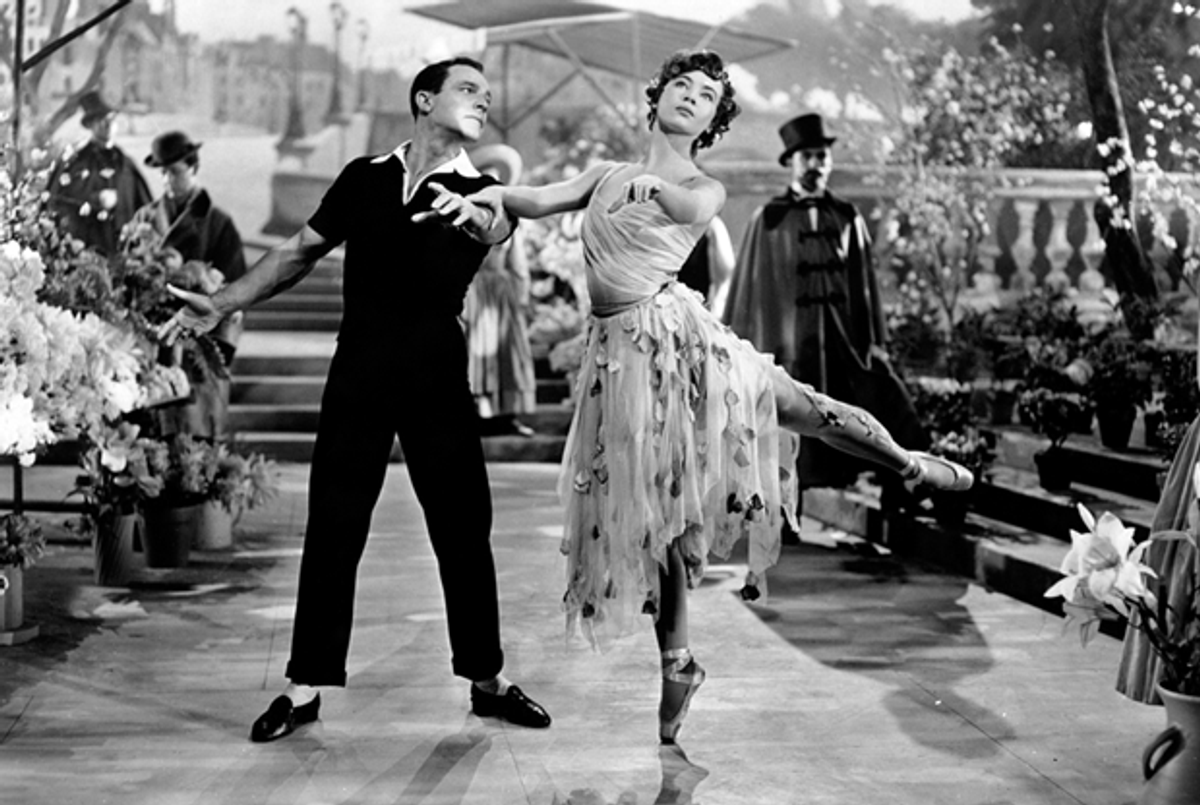
An American In Paris, the 1951 classic starring Gene Kelly, Leslie Caron, and a cast of thousands, has, like Singin’ in the Rain—its Kelly-starring and choreographed sister film of the following year—rightly been deemed by history as the apogee of the MGM musical.
Truly, it has everything: Kelly at the height of his power; Caron at the height of her loveliness; Oscar Levant at the height of his wit and musicianship; a sophisticated book by Alan Jay Lerner; a sunny score of Gershwin standards; and a twenty-minute ballet sequence which unforgettable for its athletic virtuosity and sheer magnitude of its technical accomplishment. (Kelly spent months re-designing the camera so that it could move effectively enough to capture the dynamism of the dance.) And now, in its new Broadway incarnation, An American in Paris has Nazis, or at least various explicit reminders that the romantic goings-on of these Parisians/former G.I.’s are taking place in their very long, swastika-shaped shadow—a sense that the original film is almost completely lacking.
Apart from a cursory reference made by Kelly’s character, the aspiring painter Jerry Mulligan, about “deciding to stay” when he happened to find himself in France anyway, and a few tearful but cryptic allusions made by Caron’s Lise Bouvier about owing a debt to her much older boyfriend Henri Beurel for looking after her during the war (her parents, it is intimated, were in the Resistance and almost certainly met a grisly end), the Paris of the MGM film is as picturesque and art-mad as ever, full of cheery sidewalk painters, salty old ladies running cafes, and mobs of French children clamoring for American chewing gum.
This, of course, is understandable. In 1951, the country was only six years removed from war but already deep into the “compassion fatigue” that, after the initial shock and sympathy upon being faced with horrors that had befallen Europe, characterized the attitudes of most Americans in the early 50’s. And how many pictures of atrocities can you look at before they all start to look the same? (An interesting factoid: although the publishing world was awash in the memoirs of survivors in the years immediately following the Holocaust, some of the books written in the immediate aftermath of the camps (e.g. Primo Levi’s classic The Drowned and the Saved) failed to find an audience until the early ‘60’s. It wasn’t so much that nobody wanted to talk about it; nobody was ready to hear about it.) Also, it’s hard to make even a cursory nod towards totalitarian hell with that sunny pre-war (and yes, I know how much that makes this sound like a real-estate listing) Gershwin store: can anything really be ‘Swonderful again after you’ve seen Buchenwald?
In the new stage version, all attempts have been made to put the war back in post-war. Instead of opening with Gene Kelly’s exquisite poem of movement in his tiny Parisian flat, the Jewish composer Adam Hochberg (Levant in the film) sits at a piano on an empty stage, talking frankly to the audience about darkness and swastikas. Mulligan speaks about his trauma in the trenches, and how deeply he’s trying to forget it; a dance sequence shows a French female collaborator having her head shaved before she is paraded through the streets to be jeered by the revenge-hungry crowd.
Does it work? I’m not sure—you’ll have to go and tell me! (There are many wonderful things about living in L.A. but getting to see new Broadway shows the second they go into previews is not one of them. Sigh.) But one thing is for sure: at last, the subtext has become text. It’s not that the original American in Paris didn’t know what had happened. It’s that it didn’t trust the audience to want to see it. Seventy years after the war, I guess we’re finally ready to look.
Related: Obsessed With Hollywood
Rachel Shukert is the author of the memoirs Have You No Shame? and Everything Is Going To Be Great,and the novel Starstruck. She is the creator of the Netflix show The Baby-Sitters Club, and a writer on such series as GLOW and Supergirl. Her Twitter feed is @rachelshukert.